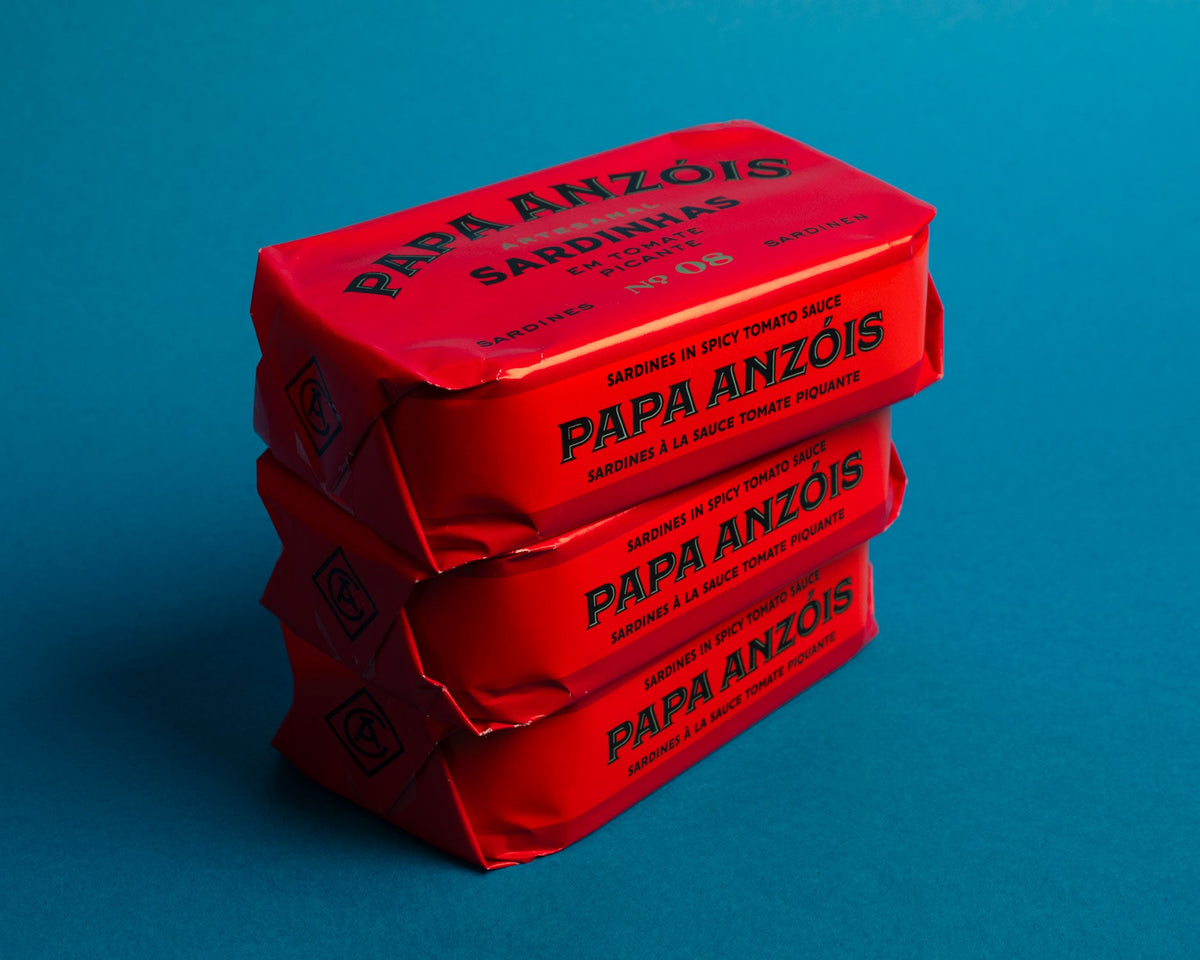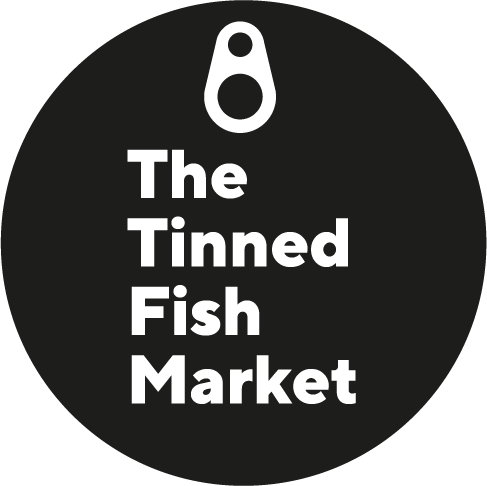

Here we look at some distinctive features of Portuguese tinned fish by Papa Anzóis tinned fish, the story of the cannery and its whimsical name, and answer questions about horse mackerel, a fish that’s neither mackerel nor horse.
IN THIS ARTICLE
Papa Anzóis in a nutshell
Papa Anzóis dehydrates rather than steams its fish prior to canning, which makes for juicier, softer-textured fish that retain more omega-3 oils and nutrients. Papa Anzóis is produced by the only certified "by-hand" cannery in mainland Portugal. The fish is caught sustainably off the Algarve coast and is complemented with high quality olive oils, lemons and peppers that are all locally grown.

What makes Papa Anzóis different from other Portuguese tinned fish?
Papa Anzóis launched in April 2021, with friends Manuel Mendes and Vincent Jonckheere determined to put a different spin on Portuguese tinned fish. The last thing Portugal needed were more quality tinned sardines in olive oil, they’d decided. The new spin? Papa Anzóis canned sardines, mackerel and horse mackerel are not pre-cooked; they’re dehydrated instead. The dehydration process takes around 20 hours, and replaces the steaming (and sometimes deep-frying) other canneries use. This makes the fish juicier and softer textured, it means more omega 3 oils and nutrients are retained and the skin is less prone to damage than with steaming.

As with all the canneries that we work with, sustainability is a signature of Papa Anzóis. The sardines are fished seasonally and to quota between May and November. And because Papa Anzóis works with small batches of fish it does not need large quantities of olive oil, lemons and peppers to complement the fish. This means that 100% of ingredients can be sourced locally. In fact, the recipes are determined by what is available close by; a sustainable way round of doing things. The mackerel and horse mackerel are fished throughout the year, because there is no shortage of them in the waters off Portugal. Like the sardines they are fished purse seine, where a net is lowered into the water and closed around the fish. This allows smaller fish to swim free and avoids damage to the sea bed which bottom trawling can cause, meaning long established habitats for marine life can continue to thrive.
The story behind Papa Anzóis
Conserveira do Arade, the cannery behind Papa Anzóis tinned fish, is located in an area of Portugal rich with canning tradition. The Algarve is divided into two zones - east (Sotavento) and west (Barlavento) where Conserveira do Arade is situated. For more than a hundred years this area was one of Portugal's major canning hubs, reaching its peak in the 1960s and 70s when the banks of the river Arade were home to 23 canneries. The area’s economy rested on canning, with 20,000 workers employed in the canneries, and more still in satellite industries: the fishermen, those working in olive oil and paprika production and the metal work industry.

But tourism usurped canning in the early 80s. This, along with new stricter fishing quotas, meant that by 1994, with investors keen to invest in hotels, the river Arade's 23 canneries had become defunct, and only two remained in the eastern Algarve. That changed in 2015, when friends Manuel and Vincent founded Conserveira do Arade. The idea of reviving the area's rich canning heritage was sparked in 2012 when Vincent visited Portimao's meticulously restored Hermanos Feu cannery (the original producers of La Rose, before Ramirez reinvigorated and launched it).
Today, the cannery that produces Papa Anzóis is the only certified artisanal cannery in mainland Portugal because it has less than 12 employees and the product is canned entirely by hand, apart from where machines are absolutely necessary such as for sealing the tins.
What is horse mackerel?
Papa Anzóis cans horse mackerel as well as mackerel and sardines. Horse mackerel isn’t mackerel but it is mackerel adjacent. We’ve filed it under mackerel on our website.
Like its namesake, horse mackerel (Atlantic horse mackerel or scad) is an oily fish replete with protein, Omega-3 and Vitamin D. And like mackerel, horse mackerel is abundant enough to be fished all year round in Portugal. But horse mackerel belongs to the Carangidae family of fish while mackerel is part of the Scombridae family and horse mackerel has a stronger taste and firmer texture than buttery-textured, milder-flavoured mackerel. Horse mackerel isn’t striped like mackerel either, but is plain in colour.
Horse mackerel is a species of jack mackerel. The scientific name for (Atlantic) horse mackerel - the fish that Papa Anzóis tin - is trachurus trachurus. Trachurus comes from the two Greek words, trachys and oura meaning rough and tail respectively, a reference to the serrated edge on the side of the horse mackerel. Horse mackerel is popular in Japanese and Mediterranean cuisine.
The name horse mackerel might derive from the Dutch word horsmakreelwhich means a mackerel that spawns in shallow sea waters. Or it may come from a legend that smaller fish rode on the backs of horse mackerel when they wanted to travel long haul.
What does Papa Anzóis mean?
"Papa (slang for eat in Portuguese) Anzóis (fish hooks) translates as eater of fish hooks"
Finally, the name. Papa Anzóis is lifted from an amateur fisherman's map that fell into Manuel's and Vincent's hands via a customer. The map shows the fishing hot spots or the rock formations where fish congregate along the Algarve coast. Papa (slang for eat in Portuguese) Anzóis (fish hooks) translates as eater of fish hooks. The rock formation in question is 10km from the cannery and is one of the most notoriously tricky for fishermen to crack, with most fishing hooks getting snagged on the rocks instead.
FAQ: How do you eat Papa Anzóis tinned fish?
Five fallback ways are with pasta, rice, salad, on toast, and with crisps. As well as simply adding the tin to pasta, you can use tinned fish to beef up a traditional pasta sauce: dice a brown onion and soften in olive oil over a low heat for about 10 minutes (you can add a diced and de-seeded chilli, diced courgette or spring onion too if you like and let them soften too) add a minced garlic clove for the last minute, and saute gently until it releases its fragrance. Add a tin of chopped tomatoes and let the sauce simmer and reduce - add the tinned fish about five minutes before the end of the cooking time to warm through. Season with salt and pepper as you go, and add herbs like oregano, sage or fresh parsley.


